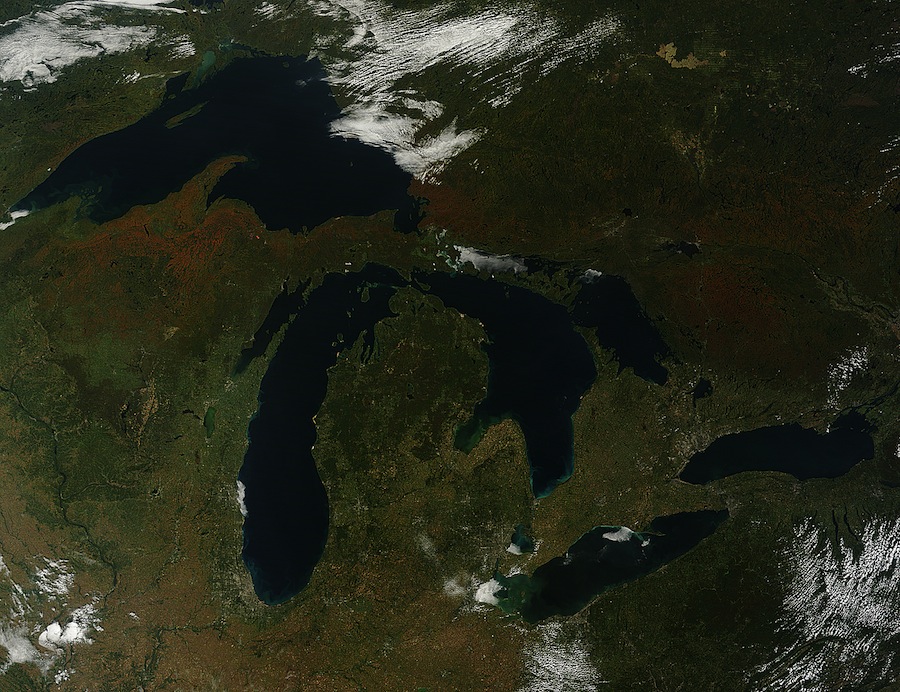Killer Shrimp Could Invade the Great Lakes

Killer shrimp, creatures that indiscriminately slay other animals without eating them, may soon join the list of invasive species living in the Great Lakes, a new study finds.
But government regulations for the exotic pet trade and commercial shipping may impede the shrimp's arrival, the researchers said.
More than 180 invasive species have made the Great Lakes basin their home in the past 200 years. Government regulations have curbed the introduction of new invasive threats, but the lakes are still vulnerable, the researchers said.
To help protect the Great Lakes, the researchers came up with three future scenarios that show other researchers and government regulators how invasive species may affect the lakes in the next 50 years. [Image Gallery: See Photos of Invasive Species]
To help people envision the future, the researchers first delved into the lakes' history. The Great Lakes act as a waterway for commercial ships. Many of these ships take in ballast water from their home ports to help stabilize the vessel, and release the water when they reach their destination. Ballast water, as well as solid ballast and marine algae on ship hulls, can carry invasive species, the researchers said.
Shipping has introduced about 60 percent of the Great Lakes' invasive species since the St. Lawrence Seaway, a waterway that connects the Atlantic Ocean with the Great Lakes, opened in 1959, they said.
The "live trade" has also allowed non-native species to establish themselves in the lakes. For example, ornamental plants, aquarium pets, baitfish and fish intended for eating, research and recreation have found their way into the Great Lakes.
Get the world’s most fascinating discoveries delivered straight to your inbox.
Overall, about 20 percent of invasive species in the Great Lakes are considered ecologically and economically damaging, and pose threats to the native biodiversity and multibillion-dollar fishing industry, the study found.
Climate change is another threat, the researchers said. Warmer temperatures may help disease organisms complete life cycles faster, they said. A temperature increase may also make the lakes more hospitable to non-native fish, such as rainbow smelt and sea lamprey, that prefer warmer waters. Fish in the lower Great Lakes may extend their range, and encroach on the normally cold waters of the upper lakes, the researchers added.
But several measures are keeping invasive species in check. In 2006 and 2008, regulations began mandating that ships release freshwater ballast water and fill their tanks with salt water before they enter the St. Lawrence Seaway. Creatures caught in the salt water aren't able to survive in the freshwater Great Lakes, the researchers said.
"No new species have been recorded since 2006," Katie Pagnucco, a doctoral student at McGill University in Montreal and lead author of the study, said in a statement. "We may have closed the door on ballast-water-mediated invasions. That remains to be seen. But other doors are still open."
Forecasts for invasive species
The researchers proposed three scenarios: pessimistic, status quo and optimistic. In the worst-case scenario, the Great Lakes would be flooded with invasive species, which could happen if ballast-water regulations are ineffective in the long term and the live trade continues to go unregulated. [The Great Lakes: North America's 'Third Coast' (Photos)]
In that scenario, new invaders, such as killer shrimp and the monkey goby — both of which are invading European waters — would likely take up residence in the Great Lakes and alter the ecosystem, the researchers said. In fact, many of today's invaders, such as the zebra mussel, come from waterways where Europe meets Asia, such as regions around the Black Sea.
In the status-quo scenario, government officials wouldn't introduce any new protective measures. But ballast-water measures would remain effective, making live trade the prime source of invasive species. The main live-trade threats would be Asian carp species, fish that adapt well to the cold waters of the Great Lakes, the researchers said. Asian carp would eat so much plankton that they could disrupt the food web and take energy away from other creatures, such as commercially fished animals, they added.
In the final view — the optimistic scenario — the Canadian and U.S. governments would work together to create regulations to minimize invasive-species risks, the researchers said.
"Invasions are a transboundary issue," said McGill University professor Anthony Ricciardi, an invasive-species biologist who supervised the study. "In addition to harmonized regulations on live trade, the two countries must coordinate early detection and rapid response to new threats — before an invasion has progressed beyond control."
The findings were published Dec. 3 in the Journal of Great Lakes Research.
Follow Laura Geggel on Twitter @LauraGeggel. Follow Live Science @livescience, Facebook & Google+. Original article on Live Science.

Laura is the managing editor at Live Science. She also runs the archaeology section and the Life's Little Mysteries series. Her work has appeared in The New York Times, Scholastic, Popular Science and Spectrum, a site on autism research. She has won multiple awards from the Society of Professional Journalists and the Washington Newspaper Publishers Association for her reporting at a weekly newspaper near Seattle. Laura holds a bachelor's degree in English literature and psychology from Washington University in St. Louis and a master's degree in science writing from NYU.



